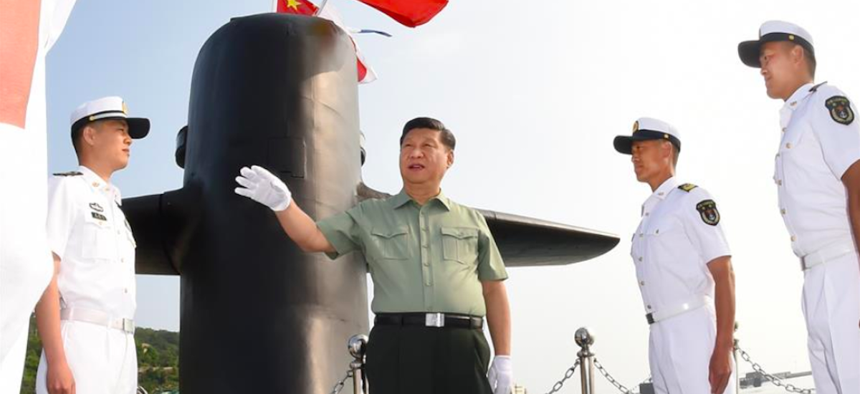
Chinese President Xi Jinping visits a submarine during an inspection to the navy under the Northern Theater Command of the Chinese People's Liberation Army, June 11, 2018. Xinhua/Li Gang
China’s Robot Subs Will Lean Heavily on AI: Report
The leader of the classified 912 Project gives a rare interview. The question, as always, is why.
A rare interview with the leader of a Chinese unmanned-submarine program offers tantalizing new hints about the direction of China’s artificial-intelligence and naval-technology efforts — as well as Beijing’s messaging and deterrence strategies.
Lin Yang runs the 912 Project, a classified program to develop new-generation military underwater robots by 2021. He told the South China Morning Post that the robot boats are intended to supplement the PLA Navy’s manned subs by handling such tasks as surveillance, minelaying, and even attacks on enemy vessels, relying on AI to adjust to changing conditions.
One close observer of China’s military technology efforts found the interview remarkable.
"It is quite striking that a senior Chinese [scientist] is willing to confirm the story and discuss a classified program, the 912 Project, in an English-language publication,” said Elsa B. Kania, adjunct fellow at the Center for New American Security. “Presumably, that uncharacteristic transparency reflects a recognition of the relevance of this disclosure for signaling and deterrent purposes."
The researchers’ statements on the new autonomous submarines reflect a recent push by Chinese media to highlight naval innovation and capabilities. The China Daily reported that during a naval inspection in Qingdao, China, in June, President Xi Jinping delivered a speech atop a new submarine recently shown in a naval parade in the South China Sea. He stressed the need “to grasp the changes of national security circumstances, speed up preparations for military struggle, including battle planning, capacity building and command system building.”
"The PLA recognizes a potential opportunity to undermine current U.S. dominance in undersea warfare,” Kania said. "It is difficult to evaluate the veracity of the story or the maturity of these efforts, so such accounts should be assessed critically but taken seriously."
Last week, Chinese media reported the unveiling of new remote-controlled undersea vehicles for “emergency rescue, marine salvage, and undersea engineering projects,” which it purported to be among the most advanced of its kind. Similarly, Chinese media released plans for a multi-functional rescue ship that will be commissioned in 2021 for use in the South China Sea. The submarines, however, would be unique in their use of artificial intelligence.
“The PLA is actively pursuing a range of AI-enabled capabilities, recognizing their potential to disrupt the military balance in the Indo-Pacific and beyond,” Kania said. “In particular, the PLA is concentrating on naval applications of AI, including for decision support and in increasingly autonomous vessels and submarines."
The U.S. Navy has also been incorporating autonomous vessels into its fleet. The Sea Hunter, an unmanned warship designed by DARPA, can navigate the ocean in accordance with international law, and also has the capacity to be armed. The Navy has enumerated plans to develop more vessels that can operate autonomously or launch drones.
Patrick Tucker contributed to this report.



